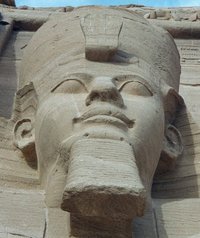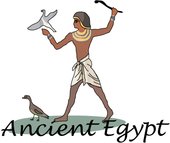Ramesses II
|
|
Ramesses II (also known as Ramesses the Great and alternatively transcribed as Ramses and Rameses) was an Egyptian pharaoh. He lived from c. 1314 BC to 1224 BC and reigned from 1290 BC to 1224 BC, He ruled for a total of 66 years, becoming pharaoh at the age of 24 and dying in his 90th year. (Note: there is some evidence that places his reign during the 10th Century BC). Ancient Greek writers (such as Herodotus) ascribed his accomplishments to the semi-mythical Sesostris.
He was the third king of the 19th dynasty, and the son of Seti I and his Queen Tuya. The most memorable of Ramesses' wives was Nefertari. Others among his wives were Isisnofret and Maetnefrure, Princess of Hatti. The writer Terence Gray stated in 1923 that Ramesses II had as many as 200 sons and 200 daughters; more recent scholars, however, believe his offspring, while numerous, were far fewer, somewhere around 90. His children include Bintah (Bintanath) (princess and her father's wife), Setakht (Sethnakhte), the Pharaoh Merneptah (who succeeded him), and prince Kha'emweset.

Ramesses led several expeditions north into the lands east of the Mediterranean (the location of the modern Israel, Palestine, Lebanon and Syria). At the Battle of Kadesh in the fourth year of his reign (1286 BC), Egyptian forces under Ramesses II engaged the forces of Muwatallis, king of the Hittites. Over the following years, neither power could effectively defeat the other, so in the 21st year of his reign (1269 BC), Ramesses concluded an agreement with Hattusilis III, the earliest known surviving peace treaty, believed to have been drawn up in 1271 BC.
Ramesses also campaigned south of the first cataract into Nubia. He constructed many impressive monuments, and more statues of him exist than of any other Egyptian pharaoh: Ramesses indeed provided the artisans who lived in Deir el Medina with plenty of work.
At least as early as Eusebius of Caesarea, he was identified with the pharaoh of whom the biblical figure Moses is popularly believed to have demanded that his people be released from slavery.
His mummy was found at Deir el-Bahri in 1881 and placed in the Egyptian Museum in Cairo five years later, where it is still exhibited with pride by the Egyptian people. His successor was his son Merneptah.
As with most pharaohs, Ramesses had a number of names. The two most important, his praenomen (regnal name) and nomen (birth name) are shown in Egyptian hieroglyphs to the right. These names are transliterated as wsr-m3‘t-r‘–stp-n-r‘ r‘-ms-sw–mry-ỉ-mn, which is usually realised as something like Wesermaatra-setepenra Ramessu-meryamen. They can be translated as 'Powerful one of Maà´¼Maat and Ra, chosen of Ra, Ra bore him, beloved of Amun'.
Related articles
External links
- TourEgypt.net site devoted to the Pharaohs, with many pages on Ramesses and his family (http://www.touregypt.net/19dyn03.htm)
- A short study of his prosperous reign (http://www.geocities.com/TheTropics/2815/ramses.html) (on GeoCities; JavaScript pop-up ad)
| Preceded by: Seti I | Pharaoh of Egypt Nineteenth Dynasty | Succeeded by: Merneptah |

